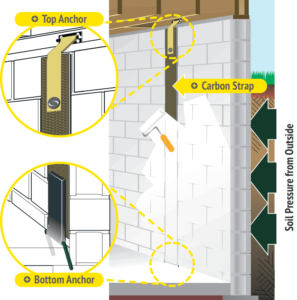The Strength and Durability of Carbon Fiber in Foundation Repair

Foundation problems can be a homeowner’s worst nightmare. However, thanks to modern technology, repairing foundation walls has never been easier or more effective. One such solution is the use of carbon fiber for reinforcing foundation walls. In this post, we’ll dive into how carbon fiber works in foundation repair and why it’s considered one of the strongest and most durable materials for this task.
What Is Carbon Fiber?
Carbon fiber is a lightweight, high-strength material made from thin, strong crystalline carbon filaments. While it is often associated with aerospace and automotive industries due to its strength and durability, it’s also highly effective in the construction industry, especially for foundation repair.
How Carbon Fiber Works in Foundation Repair
Carbon fiber is commonly used to reinforce bowing or cracked foundation walls. The process involves applying carbon fiber straps directly to the affected areas of the wall. These straps are bonded to the surface using a high-strength epoxy. Once in place, they act as a reinforcement system, preventing further movement or damage.
Benefits of Carbon Fiber for Foundation Repair
- Strength: Carbon fiber is incredibly strong, often stronger than steel, making it ideal for reinforcing foundation walls that have begun to weaken.
- Durability: Unlike steel or other materials, carbon fiber does not corrode, meaning it can provide long-lasting support to your foundation without the need for maintenance.
- Non-Invasive Installation: Installing carbon fiber straps is less invasive than traditional foundation repair methods. It doesn’t require extensive excavation or major structural changes.
- Cost-Effective: Carbon fiber is typically more affordable than other foundation repair options, offering a budget-friendly solution to homeowners facing foundation issues.
When to Use Carbon Fiber
If you’ve noticed cracks in your foundation walls or bowing basement walls, carbon fiber might be the right solution. It’s especially effective for homes with minor to moderate foundation issues, providing a non-intrusive and durable repair method.
